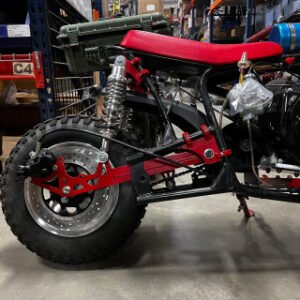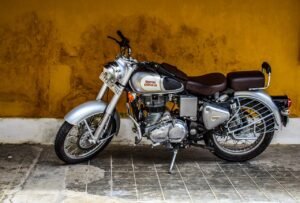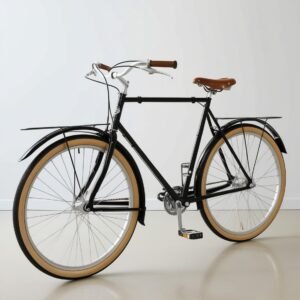What Size Bike Fenders Do I Need? A lot of cyclists believe that bike fenders are pretty much universal. Just grab a fender, throw it on, and you’re good to go, right? Well, not exactly. In reality, choosing the right size bike fender is much more important than you might think.
If you’re riding with fenders that are too big, too small, or just plain incompatible with your bike, you’ll end up facing a bunch of issues, like poor protection from mud, water, and dirt—plus, a less-than-comfortable ride.

So, how do you avoid these mistakes and pick the right fender size? In this blog, we’re going to break it all down for you. Whether you’re riding a road bike, mountain bike, or gravel bike, we’ll help you find the perfect fit, ensuring you stay dry, clean, and safe on your rides. Let’s get started!
Why the Right Bike Fender Size Matters
It might seem like fenders are just a simple add-on to your bike. After all, all they do is protect you from the mess on the road, right? Well, yes and no. While bike fenders do a great job of shielding you from dirt and water, the right size fender can actually make a huge difference in how effective it is at doing that job.
If you choose a fender that’s too small, you’re going to end up getting splashed and dirty. On the flip side, if the fender is too large, it could rub against your tires or brakes, causing friction, noise, and potential damage. So, the key is finding a fender that fits your bike just right. Let’s dig into why the right size really matters.

What Happens If You Choose the Wrong Fender Size
Choosing the wrong size bike fender doesn’t just make you look silly; it can affect your riding experience in a few ways:
- Poor Coverage: A fender that’s too small won’t protect enough of your tire, leaving you exposed to splashes and road debris. Basically, you’ll end up soaking wet and muddy halfway through your ride.
- Tire Rubbing: A fender that’s too big might actually rub against your tire or brake system, which can lead to wear and tear on both your fender and bike components. It could even create an annoying squealing noise, distracting you on your ride.
- More Bike Maintenance: A fender that’s not properly sized can let dirt and water get into sensitive parts like your chain and gears, causing them to wear out faster.
As you can see, choosing the right size fender is about more than just staying dry—it also helps your bike stay in top condition for longer. So, how do you figure out what size you need?

How to Choose the Right Size Bike Fenders
Selecting the right size fender might seem complicated at first, but don’t worry—it’s easier than you think! By following a few simple steps, you’ll be able to pick the perfect fender for your bike in no time. Let’s break it down:
Step 1: Know Your Bike Type
The first thing you need to consider when choosing bike fenders is your bike type. Different types of bikes require different fender sizes. Whether you’re riding a road bike, mountain bike, or gravel bike, each will have its own specific needs. Here’s a quick guide to help:
- Road Bikes: Road bikes usually have narrow tires and require lightweight, compact fenders. These fenders should fit snugly around the tires without adding too much bulk. If you’re riding a road bike, you’ll typically be looking for 700c fenders.
- Mountain Bikes: Mountain bikes have wider tires and are built to handle rough terrain. You’ll need larger, more durable fenders that can handle mud, water, and debris from trails. Mountain bike fenders are typically bulkier and designed to offer more coverage than road bike fenders.
- Hybrid and Gravel Bikes: Hybrid and gravel bikes have tires that fall somewhere in between road and mountain bikes. They’re typically wider than road bike tires but not as wide as mountain bike tires, so you’ll need a fender that provides a balance of coverage and protection.

Step 2: Measure Your Bike Tire Size
Next up, you’ll want to measure your bike tire size to ensure the fender fits properly. The tire size is typically printed on the side of the tire, and it will give you the information you need to choose the right fender.

- Road Bike Tires: Road bike tires are usually 700c in size, and fenders need to be sized to match these tires. For example, if you have 700x25c tires, you’ll need a fender that accommodates this size.
- Mountain Bike Tires: Mountain bikes often use 26-inch or 29-inch tires. These tires are much wider than road bike tires, so you’ll need a fender that is larger and offers more coverage, especially for wider tires (e.g., 2.3” or 2.5” wide tires).
- Gravel Bike Tires: Gravel bikes often have tires in the range of 700x35c to 700x45c. These tires are wider than road bike tires, but not as wide as mountain bike tires, so you’ll need a fender that fits this range without restricting your tire clearance.
Step 3: Choose Between Full or Half Fenders
Once you know your bike type and tire size, it’s time to decide between full fenders or half fenders. Both types have their pros and cons depending on your riding style and conditions.
- Full Fenders: Full fenders cover the entire wheel and provide maximum protection from rain, mud, and road debris. These are ideal for commuters or riders who regularly encounter wet or muddy conditions. Full fenders are best for road and hybrid bikes where you need complete coverage.
- Half Fenders: Half fenders are lighter and typically cover only part of the wheel (usually the top section). These are a good option for riders who mostly cycle on dry roads and don’t need full protection from the elements.

Choosing the Right Bike Fender Size: The Final Guide
There’s a myth that bike fenders are pretty much all the same and just “clip on” to any bike. It’s easy to think that because they all look somewhat similar—especially when you’re standing in the store or browsing online. But when it comes to bike fenders, one size doesn’t fit all. In fact, fender selection goes beyond just style. Getting the right size and type is about your bike’s specific needs, the kind of riding you do, and the weather conditions you face.
In this final section, we’ll go deeper into the importance of material selection, top fender brands, how to maintain them, and which fenders offer the best value for money. Plus, we’ll throw in some tips on seasonal care to ensure your fenders last as long as your bike does.
What Are the Best Materials for Bike Fenders?
One factor that often gets overlooked when choosing a bike fender is the material it’s made from. The material plays a huge role in how durable, lightweight, and effective your fender is. It can also impact your bike’s performance. Here’s a breakdown of the most common materials used for fenders:
Plastic Fenders: Lightweight and Affordable
Plastic fenders are the most common and are usually the go-to for road cyclists and casual riders. They’re lightweight, inexpensive, and do a good job protecting from dirt and water. But while they do their job on dry and slightly damp roads, plastic fenders might not hold up as well in rough conditions or during extreme weather.

Aluminum Fenders: Durable and Sturdy
Aluminum fenders are often seen on higher-end bikes or mountain bikes. They are more durable than plastic, providing excellent protection against dirt, water, and debris. Aluminum fenders are also less likely to crack, making them a great option if you’re biking in rough conditions or on gravel paths.

Carbon Fiber Fenders: Lightweight and High-Performance
If you’re serious about performance and willing to spend a bit more, carbon fiber fenders might be worth considering. They’re incredibly lightweight, strong, and very effective at deflecting water and dirt. Carbon fiber is often used in racing bikes and high-end mountain bikes due to its strength-to-weight ratio.

Top Bike Fender Brands You Should Know About
When it comes to choosing a reliable and high-quality bike fender, brand matters. A good brand means the fender is not only going to fit your bike well but also last longer and perform better under various weather conditions. Here are some of the top fender brands that cyclists swear by:
1. SKS Germany
SKS is a legendary name in the cycling world. Known for their high-quality bike accessories, SKS fenders are made from durable materials and offer great protection. Their fenders are available in a wide range of sizes, making them a good choice for road bikes, mountain bikes, and gravel bikes alike.

2. Planet Bike
Planet Bike is another top choice for budget-friendly fenders that still deliver on performance. They offer a variety of plastic fenders that are lightweight, easy to install, and perfect for casual cycling. Their fenders are great for commuting and are available in many sizes, so they can be adapted for most bikes.
3. Crud Products
If you’re looking for something that offers a balance of performance and price, Crud Products is another excellent option. They focus on fenders that provide good coverage without being too bulky. Their products are especially popular with mountain bikers and those who ride in wet conditions.
Maintaining Your Bike Fenders: How to Make Them Last Longer
Just like your bike, your fenders need some TLC to keep them in tip-top shape. Regular maintenance can extend the life of your fenders, ensure they work efficiently, and save you money on replacements. Here are a few tips:
1. Regular Cleaning
After every ride, especially if you’ve been in muddy or rainy conditions, it’s important to clean your fenders. Dirt and debris can build up and obstruct the fender’s ability to deflect water. Simply wipe down the fender with a soft cloth or sponge and mild soap. For tough dirt, use a brush.
2. Check for Cracks or Damage
Fenders, particularly plastic ones, can crack or wear down over time. Inspect your fenders regularly for signs of damage. If you find any cracks, it’s time to replace them before they fail to provide proper coverage.

3. Tighten Mounting Brackets
Your fender might start to loosen over time, especially if you’ve been riding on rough terrain. Make sure the fender brackets are tight and secure to avoid any wobbling or rubbing that could cause damage.
Seasonal Care: Preparing Your Fenders for Different Weather
Just like any bike component, your fenders need to be prepared for different riding conditions. Whether it’s the rainy season or a dusty summer ride, seasonal care for your fenders is essential. Here’s what to keep in mind for each season:
Rainy Season
If you live in a wet climate, it’s important to check that your fenders are securely mounted before the rainy season hits. You’ll also want to ensure they’re cleaned and free of debris, as build-up can cause blockages.
Winter Care
During winter, fenders are often exposed to slush, road salt, and other corrosive elements. Make sure to clean and dry your fenders thoroughly after every ride to prevent rust and damage. Consider investing in aluminum or stainless steel fenders, which tend to be more resistant to rust than plastic.
Dry Seasons
In dry conditions, dust and dirt can accumulate on your fenders and affect their performance. Regular cleaning is key to keeping your fenders in top condition. You may also want to check the tire clearance more frequently to ensure no debris is getting stuck.
Conclusion: Choosing the Best Fender for Your Ride
When it comes to fenders, the right size, material, and brand can make all the difference in your biking experience. Whether you’re commuting on a road bike, tackling muddy trails on a mountain bike, or cruising through gravel roads, selecting the right fender will help keep you clean and dry while also protecting your bike.
By considering factors like tire size, material quality, and installation, you can ensure your fenders perform well in all conditions. From plastic and aluminum to high-end carbon fiber, there’s a fender for every need and every budget. So, next time you’re in the market for a bike fender, make sure to follow these guidelines to find the best fit for your ride.





